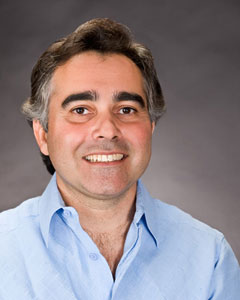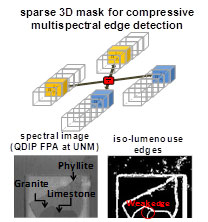Recent News
New director will enhance interdisciplinary engineering learning opportunities
July 2, 2025
Final SIRI cohort visits UNM campus
June 30, 2025
Perfetti receives ANS Landis Engineering Achievement Award
June 26, 2025
Engineering a new treatment for ovarian cancer
June 24, 2025
News Archives
Majeed Hayat Appointed Optical Society of America Fellow
November 28, 2012 - UNM Professor of Electrical and Computer Engineering Majeed Hayat has been appointed as a fellow of the Optical Society of America.
Majeed Hayat Appointed Optical Society of America Fellow
 11-28-12 – UNM Professor of Electrical and Computer Engineering Majeed Hayat has been appointed as a fellow of the Optical Society of America. The designation is given to members who have served with distinction in the advancement of optics. Hayat was cited for “pioneering the dead-space formulation of impact ionization and noise in avalanche photodiodes and developing non-uniformity correction algorithms for infrared sensors.”
11-28-12 – UNM Professor of Electrical and Computer Engineering Majeed Hayat has been appointed as a fellow of the Optical Society of America. The designation is given to members who have served with distinction in the advancement of optics. Hayat was cited for “pioneering the dead-space formulation of impact ionization and noise in avalanche photodiodes and developing non-uniformity correction algorithms for infrared sensors.”
Hayat has pioneered radically new mathematical techniques for modeling the behavior of avalanche photodiodes (APDs), ubiquitous devices that are used as to efficiently convert light to electrical current. His techniques are now widely accepted as essential for describing and engineering the fast and low-noise APDs that are incorporated in modern optical fiber communications systems and quantum communication systems.
Hayat’s theory, which is able to account for a key physical effect, called dead space, predicted that dead space can be exploited to dramatically enhance the performance of APDs. This prediction was later demonstrated experimentally by leading APD groups around the world.
Hayat has also created image-processing algorithms for reducing noise in infrared imagers, also known as focal-plane arrays (FPAs). One of the principal factors that limit the performance of FPAs is nonuniformity noise, a fixed pattern artifact superimposed on any infrared imagery.
Hayat and his students pione ered entirely new algorithms, implemented by software, for removing fixed-pattern noise in FPAs without requiring the use of a shutter, as traditionally done when fixed-pattern noise is addressed. This means that infrared cameras can be operated without the usual disruption caused by dropping a shutter periodically to clean the fixed-pattern noise. The software-based approach also reduces the manufacturing and maintenance cost due to elimination of the mechanical parts required by the shutter.
ered entirely new algorithms, implemented by software, for removing fixed-pattern noise in FPAs without requiring the use of a shutter, as traditionally done when fixed-pattern noise is addressed. This means that infrared cameras can be operated without the usual disruption caused by dropping a shutter periodically to clean the fixed-pattern noise. The software-based approach also reduces the manufacturing and maintenance cost due to elimination of the mechanical parts required by the shutter.
In addition to his faculty responsibilities, Hayat is also associate director of UNM’s Center for High Technology Materials.
Overview of Majeed Hayat’s Work
Hayat has pioneered radically new mathematical techniques for modeling the self-replicating behavior of impact ionization and avalanche multiplication in avalanche photodiodes (APDs).
His techniques are now widely accepted as essential for describing and engineering the behavior of the fast, low-noise modern APDs which are incorporated in optical fiber communications systems, high-performance imaging, and single-photon detection. This is because Hayat’s theory is able to account for the nonlocal carrier effects, or dead space, which govern the behavior of modern APDs and which enhance their performance beyond that considered physically possible according to classical McIntyre theory.
Hayat's theory has thus replaced the classical work of McIntyre, pioneered in the late 1960s, which is no longer applicable to these submicron and fast devices. His work facilitated the design of next-generation APDs that exploit the dead-space to push the noise and speed performance of APDs. His recent work on modeling of pulse collapse in single-photon APDs has solved a long-standing problem in these devices which are likely to be incorporated in next-generation quantum communication, where security is protected by quantum effects. Hayat’s work in this arena is now referenced in standard text books (e.g., Saleh & Teich, Fundamental of Photonics, Wiley, 2007).
 Hayat has also made seminal contributions in the area of image-processing algorithms for reducing noise in infrared focal-plane arrays (FPAs). One of the principal factors that limit the performance of FPA sensors is nonuniformity noise, which arises from the detector-to-detector photoresponse dissimilarities within the array. Nonuniformity is a pressing problem particularly in the mid-wave and the long-wave infrared regime. Combating nonuniformity noise is not only essential in thermal imaging and spectral sensing but also for multi-sensor systems, where nonuniformity noise leads to sensor-to-sensor irregularities, which can severely degrade the performance of the image fusion algorithms therein.
Hayat has also made seminal contributions in the area of image-processing algorithms for reducing noise in infrared focal-plane arrays (FPAs). One of the principal factors that limit the performance of FPA sensors is nonuniformity noise, which arises from the detector-to-detector photoresponse dissimilarities within the array. Nonuniformity is a pressing problem particularly in the mid-wave and the long-wave infrared regime. Combating nonuniformity noise is not only essential in thermal imaging and spectral sensing but also for multi-sensor systems, where nonuniformity noise leads to sensor-to-sensor irregularities, which can severely degrade the performance of the image fusion algorithms therein.
Hayat and his students have pioneered entirely new algorithms for reducing non-uniformity noise in FPAs that do not require shutters or black-body sources for their calibration, as traditionally done. Relinquishing the need for a shutter in IR FPAs would not only enhance the functionality of IR cameras, as they can be operated without the usual disruption caused by a shutter during the process of nonuniformity correction but also reduces the manufacturing and maintenance cost due to elimination of the mechanical parts required by the shutter. Hayat has developed two modalities of such scene-based algorithms, namely statistical and motion based, that can operate in either radiometric or nonradiometric modes.
 In the spectral-sensing arena, Hayat’s algorithmic spectrometer, co-developed by his students, is now being implemented in a smart-pixel tunable infrared camera in collaboration with his UNM colleagues Krishna and Zarkesh-Ha. This work has enabled, for the first time, multi-spectral spectral sensing without the use of spectral filters by exploiting the coarse electrically-base spectral tunablity of quantum-dot-in-a-well sensors (developed by S. Krishna) in conjunction with post-processing techniques developed by Hayat’s team.
In the spectral-sensing arena, Hayat’s algorithmic spectrometer, co-developed by his students, is now being implemented in a smart-pixel tunable infrared camera in collaboration with his UNM colleagues Krishna and Zarkesh-Ha. This work has enabled, for the first time, multi-spectral spectral sensing without the use of spectral filters by exploiting the coarse electrically-base spectral tunablity of quantum-dot-in-a-well sensors (developed by S. Krishna) in conjunction with post-processing techniques developed by Hayat’s team.
The ultimate goal of this component of Hayat’s research with his UNM colleagues is to take imaging science one step closer to the realization of an “intelligent imaging system.” Unlike conventional spectral imaging systems that sense massive amounts of data and send it to a computer port for analysis, the concept of an intelligent imager is to control the detector elements individually to sense compressively only the important information (e.g., capturing certain spectral features/signatures, motion, edges, etc.) and process its data based upon prescribed algorithms that are implemented on the sensor. The intelligent imager outputs “answers” in place of traditional imagery.
